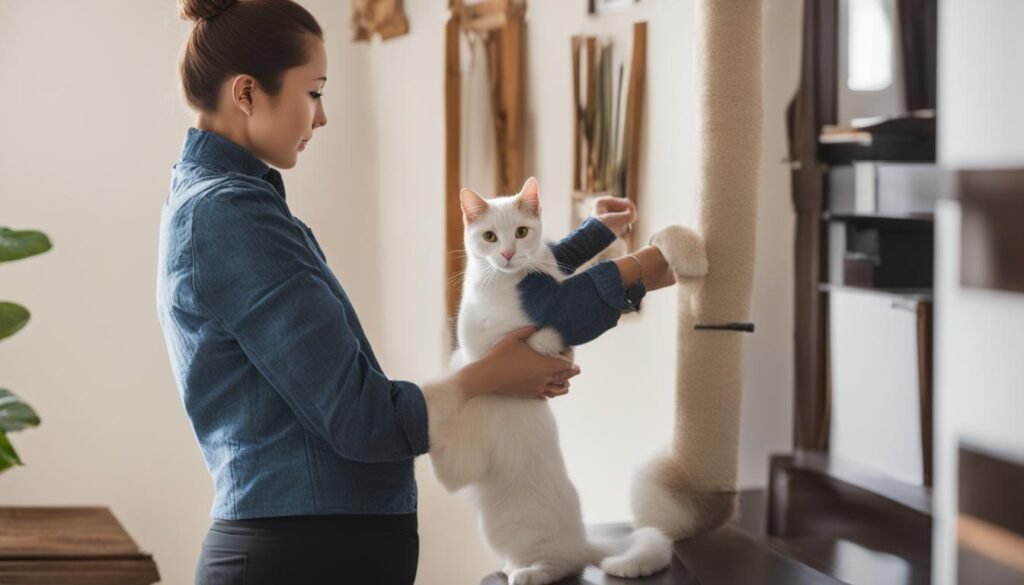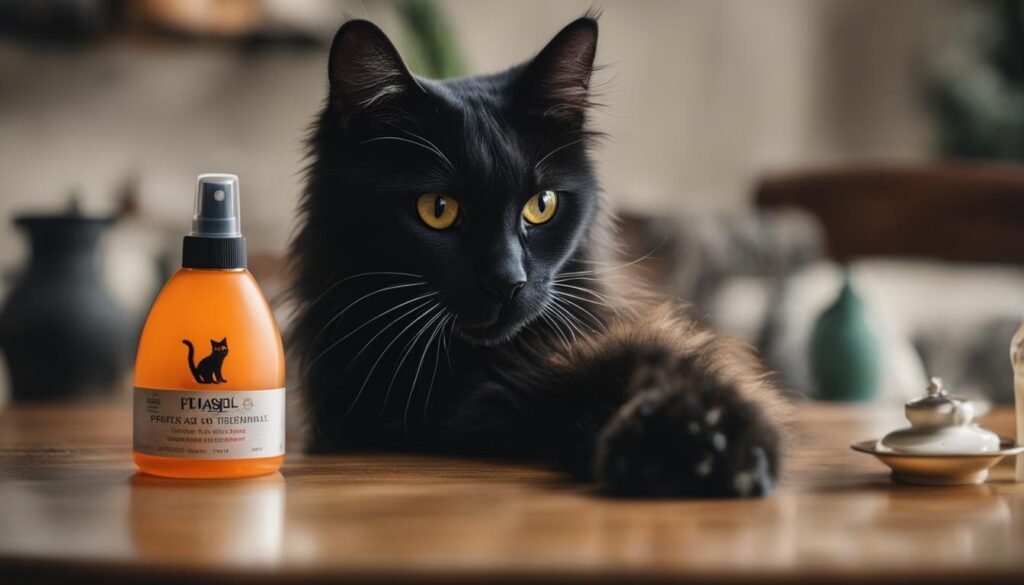Welcome to our comprehensive guide on cat conflict resolving! If you’re a cat parent looking to foster feline harmony and curb cat conflicts effectively, you’ve come to the right place. Living with multiple cats can be a rewarding experience, but it also presents its own set of challenges. In this article, we’ll equip you with the knowledge and techniques to create a harmonious environment for your furry companions.
Key Takeaways:
- Understanding cat behavior is crucial in resolving conflicts.
- Cats have their own unique behaviors and communication methods.
- Creating a secure environment and building mutual respect and trust are key to asserting dominance.
- Establish clear rules and boundaries to prevent unwanted behaviors.
- Positive reinforcement is more effective than physical punishment.
Understanding Cat Behavior
Cats are fascinating creatures with their own unique behavior patterns. To foster harmony among cats, it is crucial to understand and address common cat behavior problems. This knowledge will help cat parents effectively resolve conflicts and create a peaceful living environment.
Some of the most common cat behavior problems include inappropriate scratching, unwanted aggression, marking and spraying, and nocturnal antics. Inappropriate scratching can damage furniture and belongings, while unwanted aggression can lead to injuries. Marking and spraying, usually done by unneutered male cats, can result in unpleasant odors and territorial disputes. Finally, nocturnal antics such as excessive meowing or running around can disrupt sleep patterns for both the cats and their owners.
By recognizing and understanding these behaviors, cat parents can take appropriate actions to address and resolve conflicts between their cats. This may involve providing suitable scratching posts and toys to redirect scratching behavior, neutering or spaying cats to reduce territorial marking, and providing engaging toys and activities to combat boredom and reduce nocturnal activity.

Table: Common Cat Behavior Problems
| Behavior | Description | Resolution |
|---|---|---|
| Inappropriate Scratching | Scratching furniture or belongings | Provide suitable scratching posts and toys |
| Unwanted Aggression | Attacking other cats or humans | Identify triggers and provide behavior modification techniques |
| Marking and Spraying | Urinating and spraying to mark territory | Neuter or spay cats, provide appropriate litter boxes |
| Nocturnal Antics | Excessive meowing or running around at night | Provide engaging toys and activities, establish a bedtime routine |
Understanding cat behavior is the first step in effectively resolving cat conflicts. By addressing common behavior problems and providing appropriate solutions, cat parents can create a harmonious environment where their feline companions can thrive.
Asserting Dominance Over Your Cat
As a cat parent, it’s important to establish a sense of mutual respect and trust with your feline companion. Asserting dominance is not about hierarchy or trying to control your cat, but rather about setting boundaries and creating a secure environment. By using positive reinforcement and building a strong bond, you can effectively guide your cat’s behavior without resorting to dominance or aggression.
Cats thrive in an environment where they feel safe and understood. By providing them with consistent routines, plenty of mental and physical stimulation, and a designated space of their own, you can create a harmonious atmosphere. Positive reinforcement, such as rewards and treats for good behavior, helps reinforce the behavior you want to see from your cat. By focusing on rewarding good behavior rather than punishing undesirable actions, you can build trust and cooperation with your feline friend.
Remember, it’s important to set realistic expectations for your cat’s behavior. They are independent creatures with their own unique personalities. It’s important to respect their natural instincts and give them the space to express themselves within the boundaries you’ve set. Avoid using physical punishment or shouting, as this can lead to fear and aggression in your cat.
By asserting dominance through mutual respect and trust, you can effectively guide your cat’s behavior and create a harmonious relationship. Remember to be patient and consistent in your approach, as it may take time for your cat to adjust to the boundaries you’ve set. With love, understanding, and positive reinforcement, you can foster a healthy and happy bond with your feline companion.
| Key Points to Remember |
|---|
| Asserting dominance is about setting boundaries and creating a secure environment. |
| Positive reinforcement and rewards are effective methods for guiding your cat’s behavior. |
| Respect your cat’s natural instincts and avoid using physical punishment or shouting. |
| Building mutual respect and trust is the key to asserting dominance over your cat. |
Setting the Ground Rules for Discipline
When it comes to maintaining discipline with your cat, setting ground rules and establishing clear boundaries are essential. By doing so, you can effectively prevent unwanted behaviors and create a harmonious environment for both you and your feline companion. Consistency is key in cat discipline, as cats thrive in routine and clear expectations.
One important aspect of setting ground rules is providing multiple resources for your cat. This includes having an adequate number of litter boxes, scratching posts, and play areas. By offering these resources, you can minimize conflicts and redirect your cat’s energy towards appropriate outlets.
Remember, cats are independent creatures and require a sense of autonomy. It’s important to allow them to explore their surroundings and express their natural behaviors within the boundaries you set.
Discipline Boundaries
Establishing discipline boundaries helps guide your cat’s behavior and reinforces positive habits. For example, if your cat has a habit of scratching furniture, provide a designated scratching post and redirect their attention to it whenever they engage in the unwanted behavior. Reward them with praise or treats when they use the scratching post instead.
Consistency in discipline is crucial. Ensure that everyone in your household is on the same page and enforces the same rules. Cats can become confused and frustrated if they receive mixed messages. By maintaining consistency, you can provide a clear structure for your cat and promote better understanding.
| Discipline Techniques | Description |
|---|---|
| Positive Reinforcement | Rewarding your cat with treats, praise, or playtime when they exhibit desirable behaviors. |
| Redirecting Behavior | Guiding your cat’s attention away from unwanted actions and redirecting them towards more appropriate activities. |
| Ignoring Unwanted Actions | In certain situations, ignoring unwanted behavior can be an effective approach. This sends a message that the behavior will not be rewarded with attention. |
| Using Voice and Noise for Discipline | Using a firm voice or making a loud noise, such as clapping your hands, to startle your cat and discourage unwanted behaviors. |
It’s important to note that physical punishment or shouting should never be used as a form of discipline. These methods can lead to fear, anxiety, and aggression in cats. Instead, focus on positive reinforcement and redirection techniques to foster a healthy and well-behaved cat.

Techniques for Disciplining Your Cat
When it comes to disciplining your cat, it’s crucial to use techniques that are effective and humane. Positive reinforcement is a key strategy to encourage desired behaviors. Reward your cat with treats, praise, or playtime when they exhibit good behavior, such as using the litter box or scratching on appropriate surfaces. This helps them associate positive experiences with the right actions, reinforcing the behavior you want to see.
Redirecting behavior is another useful technique. If your cat engages in unwanted behavior, such as scratching furniture, gently redirect their attention to a designated scratching post or toy. Cats often scratch to mark their territory or relieve stress, so providing them with appropriate outlets for these behaviors can help prevent damage to your home.
Ignoring unwanted actions can also be an effective approach in certain situations. If your cat is displaying attention-seeking behaviors, such as meowing excessively or jumping on countertops, avoid giving them the attention they seek. Instead, wait for a moment of calm and reward them for calm behavior, reinforcing that quiet and calm behavior is more rewarding than demanding attention.
Using your voice and noise for discipline can be helpful in some instances. A firm “No” or a loud clap of your hands can startle your cat and interrupt undesirable behavior. However, it’s important to note that every cat is different, and while some may respond well to this technique, others may become fearful or stressed. Always observe your cat’s reaction and adjust your approach accordingly.
The use of a spray bottle as a disciplinary tool has been a topic of debate among experts. Some argue that a gentle mist of water can discourage unwanted behavior, while others believe it can create fear and anxiety in cats. It’s best to approach the spray bottle method with caution and only use it sparingly, as a last resort, if other techniques have proven ineffective. Always prioritize your cat’s comfort and well-being.
| Technique | Effectiveness | Considerations |
|---|---|---|
| Positive Reinforcement | High | Rewards desired behavior with treats, praise, or playtime. |
| Redirecting Behavior | Moderate | Guide your cat to appropriate outlets for scratching or play. |
| Ignoring Unwanted Actions | Moderate | Avoid reinforcing attention-seeking behaviors. |
| Using Voice and Noise | Variable | May startle some cats, but can be effective for others. |
| Spray Bottle | Controversial | Use sparingly and consider potential impact on your cat’s well-being. |
Specific Behaviors and How to Address Them
When it comes to cat behavior, certain issues can arise that require attention and discipline. By addressing these specific behaviors effectively, cat parents can maintain harmony and prevent conflicts within their feline family.
Biting or Attacking
One common behavior that may need disciplining is biting or attacking. This can occur during play or due to fear or aggression. To address this behavior, it’s important to redirect your cat’s attention to appropriate toys or objects. Engage in interactive play sessions using toys that mimic prey, such as feather wands or laser pointers. This helps channel their energy and predatory instincts in a positive way. If your cat becomes aggressive, firmly say “no” and withdraw your attention. Consistency in redirecting and discouraging this behavior will help your cat understand that biting and attacking are not acceptable.
Inappropriate Elimination
Dealing with inappropriate elimination, such as peeing or pooping outside the litter box, can be frustrating. Start by ensuring there are enough clean litter boxes available, following the rule of one litter box per cat plus one extra. Regularly clean the litter boxes to maintain a hygienic environment. If your cat continues to eliminate outside the box, consult with a veterinarian to rule out any underlying medical conditions. Additionally, consider using pheromone sprays or diffusers in the areas where your cat has eliminated to discourage repeat incidents. Reward and praise your cat when they use the litter box correctly to reinforce the desired behavior.
Inter-Cat Aggression
When cats in the same household display aggressive behavior towards each other, it’s crucial to intervene and address the issue. Start by providing separate resources such as food dishes, water bowls, and resting areas to minimize competition and potential conflict. Gradually introduce the cats to each other through scent swapping and supervised interactions. Use positive reinforcement to reward peaceful interactions and redirect any signs of aggression. If necessary, consult with a professional cat behaviorist for additional guidance on managing inter-cat aggression.
Disciplining a Kitten
Disciplining a kitten requires patience and gentle guidance. Use positive reinforcement to encourage good behavior, such as using treats or praise when they use their scratching post instead of furniture. Avoid using punishment techniques that may scare or harm the kitten. Consistency is key in establishing boundaries and teaching proper behavior. As kittens are still learning, provide them with plenty of toys, playtime, and outlets for their energy to prevent destructive behavior.
| Behavior | Discipline Techniques |
|---|---|
| Biting or Attacking | – Redirect attention to toys – Firmly say “no” and withdraw attention |
| Inappropriate Elimination | – Provide enough clean litter boxes – Consider pheromone sprays or diffusers – Reward and praise for using the litter box |
| Inter-Cat Aggression | – Provide separate resources – Gradually introduce and reward peaceful interactions – Consult with a professional if needed |
| Disciplining a Kitten | – Use positive reinforcement – Avoid punishment techniques – Provide plenty of toys and playtime |
Conclusion
In conclusion, resolving cat conflicts requires a combination of patience, understanding, and consistent discipline strategies. By following the tips and techniques discussed in this article, cat parents can foster a harmonious environment and minimize conflicts between their feline companions.
It is important to remember that cats have their own unique behaviors and communication methods. By understanding these behaviors and addressing them appropriately, cat owners can prevent and resolve conflicts.
Remember to set clear boundaries, establish discipline rules, and provide multiple resources for your cats. Use positive reinforcement and avoid physical punishment or shouting. With time and effort, you can build trust and mutual respect with your cats, creating a peaceful and harmonious home for everyone involved.
FAQ
How can I create and maintain harmony among cats living together?
It is recommended to adopt two kittens or longtime housemates to increase the likelihood of friendly interactions.
Why is understanding cat behavior important in resolving conflicts?
Cats are not pack animals like dogs and have different social relationships, so understanding their behavior is crucial in addressing conflicts.
What are some common cat behavior problems?
Common cat behavior problems include inappropriate scratching, unwanted aggression, marking and spraying, and nocturnal antics.
Why do cats misbehave?
Cats may misbehave due to unmet needs, reactions to specific stimuli, or boredom.
How can I discipline a cat without asserting dominance?
Asserting dominance is about setting boundaries, creating a secure environment, and building mutual respect and trust. Use positive reinforcement and avoid physical punishment or shouting.
How can I establish discipline boundaries for my cat?
Set clear rules and establish boundaries, provide a routine and clear expectations, and offer multiple resources like scratching posts, litter boxes, and play areas.
What are effective techniques for disciplining cats?
Effective techniques include positive reinforcement, redirecting unwanted behavior, ignoring when appropriate, using voice and noise for discipline, and the controversial spray bottle method.
How do I discipline a cat for biting or attacking?
Techniques for disciplining biting or attacking behavior include using positive reinforcement for good behavior and redirecting the cat’s attention when they display aggressive behavior.
How can I address inappropriate elimination (peeing and pooping in the house)?
Addressing inappropriate elimination involves identifying the underlying cause, such as a medical issue or stress, and providing a clean litter box and consistent routine.
How can I manage inter-cat aggression?
Managing inter-cat aggression involves providing separate resources for each cat, allowing for gradual introductions, and using positive reinforcement to encourage peaceful interactions.
How do I discipline a kitten?
Discipline kittens by redirecting their behavior, providing appropriate toys and playtime, and using positive reinforcement for good behavior.
